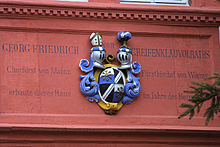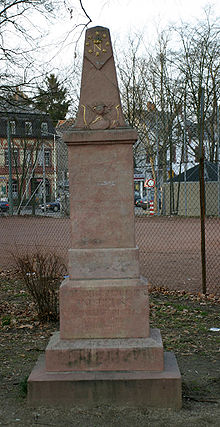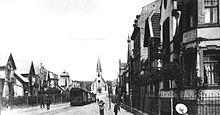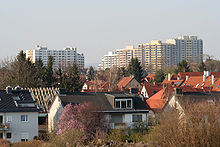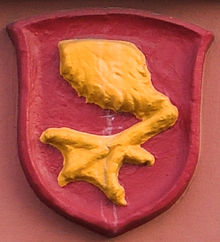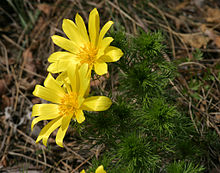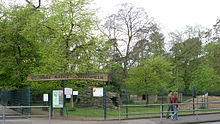Mainz-Gonsenheim
|
Gonsenheim district of Mainz |
|||||||||||||
|---|---|---|---|---|---|---|---|---|---|---|---|---|---|
| Coordinates | 50 ° 0 ′ 5 " N , 8 ° 12 ′ 30" E | ||||||||||||
| height | 136 m above sea level NN | ||||||||||||
| surface | 9.127 km² | ||||||||||||
| Residents | 25,049 (Dec. 31, 2019) | ||||||||||||
| Population density | 2744 inhabitants / km² | ||||||||||||
| Proportion of foreigners | 16.3% (Dec. 31, 2019) | ||||||||||||
| Incorporation | Apr 1, 1938 | ||||||||||||
| Post Code | 55124 and 55122 | ||||||||||||
| prefix | 06131 | ||||||||||||
Administration address |
Pfarrstrasse 1 55124 Mainz |
||||||||||||
| Website | www.mainz.de | ||||||||||||
| politics | |||||||||||||
| Head of town | Sabine Flegel ( CDU ) | ||||||||||||
| Allocation of seats (local advisory board) | |||||||||||||
|
|||||||||||||
| Transport links | |||||||||||||
| railroad | Station on the Alzey – Mainz line | ||||||||||||
| tram | MVG Mainz line 50, 51 | ||||||||||||
| bus | MVG Mainz line 58, 62, 71, 74, 76, 92, 93, MVG Mainz + ESWE Wiesbaden community line 6, MVG Mainz + ORN community line 68 | ||||||||||||
Gonsenheim is a district of the Rhineland-Palatinate state capital Mainz .
With over 25,000 inhabitants (main residence), Gonsenheim is the second largest district in the state capital after the Neustadt in terms of population.
The history of Gonsenheim goes back to the late Neolithic (2800 to 2400 BC). Gonsenheim gained importance as a settlement with the establishment of a Franconian settlement in the 6th century, which developed rapidly, mainly due to its favorable location for arable farming. In 1938 Gonsenheim was forcibly incorporated and thus part of Mainz.
Today Gonsenheim is still partly characterized by a village, despite its 80-year affiliation to Mainz. In addition to the old town center around St. Stephan and the Renaissance town hall, there are the mansion and working-class quarters that were built at the beginning and middle of the last century, the high-rise quarter, which offers around 6000 people living space, the “Am Hemel” industrial area and naturally shaped areas : The botanically important nature reserve “ Großer Sand ” and parts of the Lennebergwald , the largest contiguous forest area in Rheinhessen .
Neighboring districts and municipalities
Gonsenheim is located in the west of Mainz. The following municipalities or districts of Mainz border Gonsenheim in a clockwise direction:
in the north mombach , east Hartenberg-Münchfeld , in the south Mainz-Bretzenheim and Mainz-Drais , in the West Mainz-Finthen and in the northwest Budenheim .
history
With the first written mention of Guntzinheim on November 13, 774, Gonsenheim has a well-documented local history that goes back over 1200 years. But traces of human activities and settlements can be traced back to the late Neolithic.
Early days
Finds of prehistoric people in Gonsenheim can be dated back to the late Neolithic (2800 BC to 2200 BC). The Beildepot find in the Gewann Auf dem Kästrich (today: "An der Ochsenwiese") near the Gonsenheim train station is likely to have a supraregional significance for the prehistory of Gonsenheim . Here, in 1850, five polished, flat jadeite axes were found in the sand dunes typical of Gonsenheim, which can be attributed to the late Neolithic. At that time, these splendid axes were of great material value and were probably imported from the Maritime Alps . From the time of the tumulus culture (1600-1300 / 1200 BC) there are some grave finds from tumuli in Gonsenheim; the settlements belonging to this have not yet been localized.
Traces of human settlement in Gonsenheim can be dated for the first time to the Late Bronze Age ( Urnfield Age , approx. 1200 to 750 BC). From this time there are certain settlements in the western Gonsbachtal. These traces of settlement date to the late Urnfield Period or even to the early, from 750 BC. Beginning of the so-called Older Iron or Hallstatt Age . The Hallstatt period was associated with a significant increase in the number of settlements in the Mainz urban area, including in Gonsenheim. Traces of settlement from both the older and the younger Hallstatt period were found, for example on the lower slope of the Gleisberg or on the Mühlweg.
According to the current state of knowledge, the Gonsbachtal seems to have been uninhabited again in the Younger Iron or Latène Age (approx. 450 BC to 15 BC). It was left to a Celtic settlement of the later Latène period in Mainz-Weisenau to become the nucleus and namesake for the Roman Mogontiacum .
Romans
At the time Mogontiacum belonged to the Roman Empire , the Roman road Mogontiacum-Bingium ( Bingen ) was located near Gonsenheim. On the Gleisberg a villa rustica with numerous building and small finds such as B. mosaic floors, wall plaster, remains of a Roman bathing building and an associated water pipe can be detected. Numerous other small finds such as coins, terracottas, glass vessels in many districts as well as the presence of Roman cremation graves in the area of today's industrial area attest to the presence of the Romans in Gonsenheim. In 2013/2014, extensive structural remains from the period around the 4th century were found in the Gonsbach valley during renaturation work , which the archaeologists responsible identified as a stud , which was possibly operated by the military stationed in Mogontiacum.
After the collapse of the Limes in the middle of the 3rd century, at the latest from the 4th / 5th. In the 19th century, the Roman-Celtic rural population from Gonsenheim fled to the better fortified city of Mogontiacum.
Francs
Despite the extensive pre-Franconian history, the founding of a permanently inhabited settlement Gonsenheim is dated to the Franconian period. The founder is likely to have been a Franconian nobleman named Gunzo , who founded a larger homestead in the area of today's Gonsenheim as the nucleus for the later settlement. Establishments with the name ending -heim are typical for the establishment of settlements in the course of the so-called Frankish conquest , which took place in the late 5th to 7th centuries. Gonsenheim is one of the foundations of other Mainz suburbs such as Hechtsheim, Bretzenheim, Ebersheim or Laubenheim, which were also founded during this period.
Already on November 13th 774 Gonsenheim was mentioned for the first time as "Guntzinheim" in a deed of donation from King Charles to the Fulda monastery . In another, dated May 30, 775, deed of donation to the Lorsch Abbey (document no. 1090 of May 30, 775), the place is called "Gunsenheim im Wormsgau " . A donation from a certain Teurath was notarized, who gave the abbey five yoke of arable land and a meadow in the district of Gunsenheim. Further donations, some of them extensive, to various monasteries (especially Lorsch) followed, especially in the Carolingian period when Gonsenheim was a "royal estate" . Overall, Gonsenheim is mentioned in five documents in the 8th century.
middle Ages
The Mainz Wall Building Regulations, which were adopted in 10/11. It originated in the 18th century and indicates the medieval links between Gonsenheim and Mainz. In the Middle Ages, Gonsenheim belonged to a group of 35 privileged villages near Mainz. These were allowed to trade in the city without paying the usual market duty, and the residents of Gonsenheim were able to flee to the fortified Mainz in times of war. In return, they undertook to maintain three “town battlements”, which meant that they were responsible for the maintenance and defense of part of the Mainz city wall.
Gonsenheim continued to develop in the Middle Ages. Although there were many different feudal estates in Gonsenheim, especially of a church type, the electors from Mainz never gained local rule. However, they were recognized as sovereigns and thus had some rights such as high jurisdiction, the collection of the appraisal or the obligation of the citizens to military service. The cathedral provost ruled the place , who in turn appointed officials (from 1350 civil officials).
The Gonsbach mills were first mentioned in 1350. Four of the eight mills belonged to Gonsenheim. For the year 1365, Gonsenheim had around 160 inhabitants, a relatively large number for those times. In 1401 the local church " St. Stephanus " was first mentioned in a list of goods. The St. Peter monastery in Mainz owned vineyards in the immediate vicinity. From the Middle Ages to modern times, St. Stephen's Church was continuously expanded and in some cases even completely rebuilt, until it reached today's size at the beginning of the 20th century, which earned it the name Rheinhessendom . Starting from St. Stephan, Gonsenheim grew in the 16th century mainly along the "long local road", today's Mainzer Straße. In 1615, the provost and later Elector of Mainz, Georg Friedrich von Greiffenclau, built the court and town hall. The splendid and representative Renaissance building with bay window, stair tower and roll-work gable became the center of Alt-Gonsenheim together with the directly neighboring St. Stephan church.
The place survived the Thirty Years War relatively unscathed. Around 400 inhabitants are given for the year 1665, but the plague epidemic that broke out next year is said to have halved the number of inhabitants. Further epidemics led to the introduction of the Fourteen Helpers Pilgrimage, which still exists today, in 1729. In addition, a fourteen emergency helper chapel was built in the Gonsenheim forest, which in the form rebuilt in 1894/1895 is still an important part of Gonsenheim's church history.
In the course of the Electoral Mainz reform efforts in education and school policy, Gonsenheim received a school building in 1779 as an extension to the town hall. In general, the 18th century is considered to be a rather peaceful time for Gonsenheim and the Mainz suburbs, while in Gonsenheim horticulture (vegetable and fruit growing) in particular flourished and became an important supply factor for Mainz. With the French Revolution and the advance of the French Revolutionary Army under General Custine in 1792, however, a new era dawned for the Gonsenheimers towards the end of the century.
Modern times
On October 18 and 19, the leaders of the French revolutionary army also reached the Mainz suburbs. Although a " freedom tree " was also erected in Gonsenheim , the Gonsenheimers were otherwise politically restrained, in contrast to the residents of z. B. Weisenau or Bretzenheim / Zahlbach. In 1795 Gonsenheim housed 7,000 French soldiers alone. From 1798 until 1814 it belonged to the French- administered canton Nieder-Olm , which from 1800 belonged to the newly founded French Département du Mont-Tonnerre (Donnersberg). On September 30, 1804, the extensive area of the Great Sand was used for the first time for a five-hour military maneuver in the presence of Napoleon. Further maneuvers up to the present should follow there.
Gonsenheimers also fought for Napoleon in the Grande Armée . Of the 40 conscripts from Gonsenheim, 11 died in the Napoleonic Wars . Surviving veterans founded a Napoleon Society in memory of this time and in 1839 set the Napoleon Stone in the "Pfarrer-Grimm-Anlage", a veteran memorial.
In 1815 Gonsenheim had around 1,200, in 1843 even around 2,200 inhabitants. After the withdrawal of the French in January 1814 and the Congress of Vienna in 1814/1815, the place now belonged to the newly formed province of Rheinhessen in the Grand Duchy of Hesse-Darmstadt . The conservative politics of the Grand Duchy soon stood in opposition to the Rheinhessen, which had been more liberal since it became part of France. In Gonsenheim this led to an active role in the March Revolution of 1848/49. Two of the most important figures of the Mainz liberals acted in the inn “Zum Goldenen Stern”: Dr. Ludwig Bamberger and Dr. Franz Heinrich Zitz . Together with a Rhenish Hessian Freikorps , Gonsenheimer “Freedom Men” went into battle in the neighboring (Bavarian) Palatinate under their leadership. On 14 June 1849, however, the corps was defeated in Kirchheimbolandener castle garden the superior Prussian forces under the later Emperor Wilhelm I .
Regardless of these turbulent times, Gonsenheim continued to grow as a place, albeit not as strongly as the working-class suburbs of Weisenau and Mombach . The creation of "Hinteren Grabenstrasse" was followed by "Finther Strasse", "Palmen" and "Untere Mombacher Strasse". In 1866 a major fire destroyed the old bells of St. Stephen from the 16th and 17th centuries. At the same time, a cholera epidemic ended that killed 10% of the population. In 1870/71 Gonsenheimers went to war again: 5 of the 59 Gonsenheim soldiers died in the Franco-German War .
Gonsenheim finally came into modern times in 1871 with the opening of the Ludwigsbahn (Mainz-Alzey) and the connection to the railway network. In 1892 the steam train from Mainz via Gonsenheim to Finthen was opened. At the beginning of the 20th century, Gonsenheim also received gas and water pipes and a sewer system. Gas and water works were built, and the electric tram was introduced in 1907 following the Mombacher line. Gonsenheim got electricity in 1910. In 1909 the aviation pioneer Jacob Goedecker (1882–1957) built an aircraft factory in Gonsenheim. At that time the airfield and hangar were located on Großer Sand, an ideal flying site.
The population grew slowly but steadily from around 4,880 inhabitants in 1905 to around 6,200 inhabitants in 1920. Since workers of the Protestant faith also moved to Gonsenheim and the neighboring town of Mombach, a Protestant church was built in 1903 at the end of "Breite Straße". Around 1900 the first Jewish family moved to Gonsenheim. It is no longer possible to determine precisely how large the Gonsenheimer Jewish community that emerged afterwards was in the time before the Second World War. At least 20 Gonsenheimers of Jewish faith were later to be deported to the Theresienstadt concentration camp or other extermination camps, with only one woman from this group surviving.
In 1895 Gonsenheim advanced to a garrison location with the stationing of the Nassau Field Artillery Regiment No. 27. For many years there were so-called imperial maneuvers in the Großer Sand , the last time in 1913. Emperor Wilhelm II took them off when he was in Wiesbaden for a cure. In 1931 two SA storms were set up in Gonsenheim; In the 1933 Reichstag election, Adolf Hitler and his NSDAP received 43% of the votes cast in Gonsenheim, which is 80% Catholic. The Kathen barracks were completed in 1937 . (→ Occupation of the Rhineland (1936) )
On April 1, 1938, Gonsenheim was finally incorporated into Mainz for military and political reasons. The well over 1000-year history as an independent village in the run-up to Mainz came to an end, although some typical village structures have been preserved in Gonsenheim into the 21st century.
Gonsenheim today
With the incorporation of Gonsenheim into Mainz, Gonsenheim's history as an independent place ended, but life didn't change too much for the time being. Gonsenheim continued to be a rural place.
During the Second World War , Gonsenheim was bombed several times in the course of the air raids on Mainz , the number of civilian victims was almost 600 inhabitants. On March 21, 1945, the time of National Socialism ended for Gonsenheim , the American armed forces marched in. Since Gonsenheim belonged to the French-occupied zone in the immediate post-war period , the place had a French occupation in the Mangin barracks from 1946 to 1948 . From 1949 onwards, American forces were stationed again and were to remain in Gonsenheim for almost 50 years. They took over the Kathen barracks built in 1938, which from then on operated under the name Lee Barracks . American soldiers, their families and their housing estates as well as the "Panzerwerk" MIP Mainz Industries Panzerwerke located on the border with Mombach were to shape the Gonsenheim townscape for the next few decades.
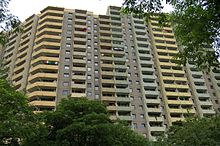
In the course of the post-war period, agriculture, which had dominated Gonsenheim for centuries, continued to decline. For this purpose, a new Gonsenheim district was created in the form of the “Am Hemel” industrial park, where more and more representatives from the service, trade and industry settled. A forerunner of today's Lotto Rheinland-Pfalz GmbH was founded in a restaurant in Gonsenheim on November 20, 1948 .
At the end of the 1960s, the A 643 was built across the Großer Sand nature reserve as part of the motorway expansion around Mainz ( A 60 , the so-called Mainzer Ring ) . It established the motorway connection in the direction of the Rhine to Wiesbaden. In 1972/73, housing in Mainz was increasingly relocated to the outskirts, including Gonsenheim. The skyscrapers were built in Elsa-Brändström- Strasse, with living space for 6,000 people. For administrative reasons, Gonsenheim ceded the districts of Hartenberg and Münchfeld in 1989, which (together with parts of the former inner city district ) became a separate Mainz district of Hartenberg-Münchfeld .
After the withdrawal of the American armed forces in the 1990s, larger areas became available, especially in the area of the former American barracks Lee Barracks. A Gonsenheim building project there, the “Am Gonsenheimer Sand” residential park, provided living space for a further 4,000 people. The largest construction project in Gonsenheim in the 2010s was the development of the site of the former tank works on the border with Mombach. Another residential park was built here on the approx. 24 ha large conversion area east of the district with the “Gonsbachterrassen”.
Local administration
town hall
The local administration of Gonsenheim is housed in the Gonsenheim town hall, a Renaissance building from 1615.
Mayor and local advisory board
Since the elections for the local council in 2019, the following parties have been represented in the local council:
Sabine Flegel (CDU) has been the mayor of Gonsenheim since 2004. Your deputies are Mathias Huber (CDU, 1st deputy) and Jens Carstensen (SPD, 2nd deputy).
Municipal institutions
- Gonso - children, youth and culture center
- Mainz-Gonsenheim district library
- Elsa-Brändström-Straße district meeting place (sponsored by a private foundation)
Economy and Infrastructure
traffic
The train station ( 49 ° 59 ′ 52.1 ″ N , 8 ° 12 ′ 52.1 ″ E ) is located south of the town on the Alzey – Mainz railway line, which opened in 1871, and offers regional rail connections to both cities and direct connections to during rush hour Frankfurt am Main. Gonsenheim is also well connected to the rest of the city and to Wiesbaden thanks to several bus and tram lines operated by the Mainz transport company (for details, see info box). Mainz city center can be reached in around 15 to 25 minutes, depending on the line. With the timetable change in December 2019, a direct connection to the Mainz districts of Bretzenheim, Hechtsheim and Mombach was established for the first time via the new line 74, which does not run through the city center.
Gonsenheim is located in the tariff area of the Rhein-Nahe-Nahverkehrsverbund and the Rhein-Main-Verkehrsverbund .
Established businesses
The trade association for wood and metal , the credit insurer Coface Deutschland and Aareon AG , among others, have their headquarters in the Kisselberg industrial park , on the border with Hartenberg-Münchfeld. Several craft businesses are located in the nearby Am Hemel industrial park .
Coat of arms and name development
The coat of arms of Gonsenheim shows a golden goose foot in the escutcheon on a red background. In older local coats of arms images, St. Stephan can sometimes still be seen as a coat of arms holder. This is a so-called “talking coat of arms”, the motif of which refers to the late medieval-modern name form (here: goose, geese). The coat of arms therefore has nothing to do with the historical origin of the name “Heim des Gunzo” (see history: Franconian period). The same also applies to the other Franconian foundations of Bretzenheim, Hechtsheim and Laubenheim.
The name development of the place name Gonsenheim:
- Guntzinheim (774)
- Gunsenheim (775)
- Gunt (z) inheim (779)
- Gunsanheim (788)
- Gunsenum (1200)
- Gonsenheim (from the 17th century)
Development of the population
|
|
Schools and further education
- Maler-Becker School (primary school)
- Martinus School (primary school sponsored by the Diocese of Mainz )
- Elementary school "Am Gleisberg"
- Kanonikus-Kir-Realschule (Realschule)
- Otto-Schott-Gymnasium with the School for the Promotion of Gifted Students / International School ( AbiBac )
- Volkshochschule Mainz with its branch in Gonsenheim.
Until 2010, Faculty III of the Mainz University of Applied Sciences was located at the “Bruchspitze” location .
Associations and groups
Gonsenheim has a rich club life. In addition to associations, some of which are more than 150 years old and which represent the old, rural traditions, there are also numerous new foundations in all areas of association life. Not to be forgotten are the carnival clubs, which also have a long tradition in the Mainz carnival stronghold of Gonsenheim.
The association ring Gonsenheim takes on the coordination of this diverse club landscape . a. is also responsible for the jointly designed summer festival in the Pfarrer-Grimm-Anlage and organizes the Gonsenheim Advent market on the 1st weekend in Advent. Well-known clubs in Gonsenheim are z. B. the sports clubs Turngemeinde 1861 Mainz-Gonsenheim (whose volleyball team plays in the second Bundesliga), SV Gonsenheim and the baseball club Mainz Athletics , which plays in the first Bundesliga and was German baseball champion in 2007 and 2016.
The two Catholic parishes St. Stephan and St. Petrus Canisius have their own choirs; In addition, there are several music associations in Gonsenheim, the oldest of them being the MGV Cäcilia Gonsenheim choral association, founded in 1845 with four choirs.
The Gonsenheim local history and history association offers an extensive program of activities (excursions, lectures) and has been running a local history museum not far from the old town center for several years (location: Budenheimer Straße).
For the carnival clubs, see the section Gonsenheim Carnival .
gastronomy
Of the old village restaurants in Gonsenheim, there is only the Zum Bürgerhof restaurant in the vicinity of the gym, which existed at the end of the 19th century. Today Gonsenheim offers a wide gastronomic cross-section. In addition to home-style cuisine, there are restaurants, pubs, wine bars and snack bars with Indian, Greek, Italian, Turkish, Asian and Mediterranean cuisine.
Festivals and general events
In Gonsenheim, which has been catholic since time immemorial, the traditional parish festival is still celebrated, as is the custom in village areas. In addition there is the “curb”, which was previously prepared by the respective “notch year” and which is accompanied by a fair on the Juxplatz.
The park festival , which took place for the first time in 2003, has replaced the former town hall and courtyard festival in Mainzer Straße and is now organized annually by the Kleppergarde and Gonsenheim clubs. The park festival, in which most of Gonsenheim's associations and groups take part, takes place in the Pfarrer-Grimm-Anlage as well as in the neighboring Kirchstrasse. The Advent market on the first weekend of Advent has also become a tradition , supported by Gonsenheim associations, groups, schools and kindergartens in the same place. In addition to these “official” events, there are also street festivals in various Gonsenheimer Straße and their residents, for example in Engelstraße or Elsa-Brändström-Straße with their high-rise quarters.
Overview
- Mardi Gras parade and foolish recruit parade (Mardi Gras Saturday)
- Horse show of the Gonsenheimer Reit- und Fahrverein ( Holy Saturday to Easter Monday)
- Parish festival St. Petrus Canisius on the Gleisberg (weekend after Pentecost)
- Spring festival on Juxplatz (second weekend in May)
- Strawberry Festival (May)
- Park festival in the Pfarrer-Grimm-Anlage (in July / August)
- Curb on the Juxplatz (August)
- St. Stephan summer festival on the parish hall (first weekend in September)
- Advent market in the Pfarrer-Grimm-Anlage (first Advent weekend)
Gonsenheim Carnival
Gonsenheim is known as the "Mardi Gras stronghold" in Mainz. It may not have as extensive a carnival procession as the neighboring Finthen district, but several clubs and gardens. They hold numerous meetings and send their active members to other meetings and parades; As in many other places, the town hall is stormed and the Gonsenheim associations organize a parade of recruits.
Gonsenheim carnival clubs have a long tradition. The oldest association is the CV Kleppergarde 1877 e. V. Gonsenheim . (In contrast to the similarly uniformed Mainz Kleppergarde , the name does not come from rattling, but rather from horses.) Originally founded by Gonsenheim farmers and carters as the Kleppergarde savings association, the association was renamed in 1952 to mark the 75th anniversary of the association. The second oldest and largest carnival club on site is the Gonsenheim Carnival Association "Schnorreswackler" 1892 e. V. (GCV). The original founding name was also here "Spar- und Karnevalsverein Schnorreswackler". The founding fathers in 1892 all had significant mustaches in the Wilhelmine tradition (in the Mainz dialect: Schnorres ), which, according to contemporary statements, could get violently in motion in the heat of the battle in the campaign. The GCV is the association which, together with three other associations, supports the television session “Mainz remains Mainz”. In 1946, members of the Gonsenheimer Turngesellschaft (TGS 1899) formed the group of Gonsbachlerchen around Josef (Joe) Ludwig and Herbert Bonewitz . The Gonsbachlerchen were a part of the program at the Mainz Carneval Association (MCV) for a long time. From 1953 also active in the carnival event of the Gonsenheim Carnival Association "Schnorreswackler" (GCV), the Gonsbachlerchen became known nationwide.
Since the GCV does not have its own guard, the association cooperates with the Gonsenheim Fusilier Guard, which was founded in 1953, as part of the “Foolish Axis”. The guard, which has more than 700 members (the largest independent guard in Mainz), has everything that can be mobilized for the Mainz hall and street night: officers and amazon corps, a modern music procession, large equestrian corps, flag and majorette corps, cadet corps, a legion of honor as well as guard ballet, show dance and children's ballet.
Guard uniform and regimental flag are vaguely based on the historical model, the former Hessen-Kasseler-Fusilier Regiment No. 80, which was stationed in Gonsenheim during the Palatine War of Succession in 1689. The guard march of the Fusilier Guard is the old guard march of the infantry body regiment "Grand Duchess" (3rd Grand Ducal Hessian) No. 117, which was stationed in Mainz until the First World War .
One year after the "Spar- und Karnevalsverein Schnorreswackler", in 1893, the Carnevalverein Eiskalte Brüder was founded. According to tradition, the founding meeting took place in winter in the back room of a Gonsenheim inn - with the stove not working. The club name was thus born quickly. The local connection to Gonsenheim is very important to the Eiskalten Brothers, which is particularly expressed in the popular “Alt Gunsenum” session. This event has been held since 1961 and has become one of the highlights of the Mainz Carnival. The ice-cold brothers are therefore celebrating the 50th birthday of "Alt-Gunsenum" in the 2011 campaign.
Even before the Second World War, the Catholic church environment formed the breeding ground for various carnival activities. Thus, out of the Marian Congregation, Shrovetide sessions in a small social setting emerged. After being banned during the Nazi era, the tradition was continued in the Sängerheim restaurant in the 1950s and in the large gymnasium since the 1970s. Since the beginning of the 1980s, the traditional parish night as an ecumenical meeting of the 3 Gonsenheim parishes St. Stephan, St. Petrus Canisius and the evangelical congregation has taken place. In these sessions the first intensive youth work was carried out, from which many Gonsenheim carnival greats such as GCV Ballet, and many active members of the GCV and the Fusilier Guard grew.
Buildings worth seeing
Mainz-Gonsenheim has a total of eleven monument zones and many individual monuments, including the local church of St. Stephan, the Vierzehn-Nothelfer-Kapelle and the Maler-Becker-Schule . For a complete overview, see the list of cultural monuments in Mainz-Gonsenheim .
Gonsenheim town hall
Built in 1615 by the cathedral provost and later Elector of Mainz, Georg Friedrich von Greiffenclau, as a court and town hall. Construction elements such as roll-work gables , bay windows and the stone stair tower indicate the architectural style of the later Renaissance period. In 1779 the construction of an extension to the town hall began, which served as a school building. The interior of the building can be viewed during the city hall's opening times. Every second Thursday of the month, the registry office enables weddings in the representative baroque hall.
St. Stephan
The local Catholic church of St. Stephan was first mentioned in a document in 1401. With several new buildings and renovations, most recently in 1906 by Ludwig Becker , the church in the neo-Gothic style was given its present-day imposing shape with the nave over 62 m in length and the two almost 60 m high church towers. Since it was the largest country church in Rheinhessen, St. Stephan was soon referred to as the "Rheinhessendom".
Protestant church
Located in the middle of a traffic island at the beginning of the Breite Straße , this first Protestant church in Gonsenheim was consecrated in 1903. Since 2003 it has been equipped with a total of eight windows by the well-known glass artist and painter Professor Johannes Schreiter .
Fourteen Holy Helpers Chapel
The fourteen helper chapel was built in 1729 on the basis of a vow made by the Gonsenheimers in the Gonsenheim forest. The current design of the chapel is based on the new building in 1895. The chapel is at the end of Kapellenstrasse on the edge of the Gonsenheim forest. The Gonsenheim Wildlife Park and the Wendelinusheim in the forest are both just a few minutes' walk away.
St. Petrus Canisius
The Catholic parish church of St. Petrus Canisius in Gonsenheim was built in 1956. As early as 1925 a community of Gonsenheim citizens was formed who lived a long way from St. Stephan. Immediately after the Second World War, this was elevated to the status of its own parish curate and on February 1, 1950, to its own parish. On July 22, 1956, Bishop Albert Stohr consecrated the new parish church. The building by the architect Hugo Becker (1897–1967) is now a listed building as one of the earliest examples of modern post-war architecture.
Monuments
Napoleon stone
The “Monument to the Gonsenheimers who fell under the flags of Napoleon” (according to the main inscription) was erected in 1839 by the Gonsenheim Napoleon Society and renovated again in 1926. The memorial is in the Pfarrer-Grimm facility directly on one of the main paths. It is one of the three veteran monuments of this type in Mainz. The other two monuments are located in the main cemetery in Mainz and in Hechtsheim, which was erected in 1834. The monument is made of red sandstone and adorned with the “Napoleonic N” and surrounding stars that are covered with gold. Listed are the fallen and the army units (including the famous "Old Guard") to which they belonged under Napoleon.
Obviously, the Napoleonic campaigns, in which around 40 young Gonsenheimers had to take part, were nostalgically glorified by the returned veterans afterwards and remained in positive memories, including the memory of the fallen brothers in arms.
War memorials
The memorial of the Nassau Field Artillery Regiment No. 27 Orange , which commemorates the fallen soldiers of the artillery regiment stationed in Gonsenheim, is in the Pfarrer-Grimm facility. The memorial was erected in 1933 for the 100th anniversary of the regiment. The memorial of the Ludwigverein (an association of Grand Ducal Hessian officials from Gonsenheim) from 1863, a few meters away, commemorates the Gonsenheimers belonging to the Grand Duchy of Hesse-Darmstadt and was later supplemented with the lists of names of the Gonsenheimers who died in the First World War .
Another war memorial, which generally commemorates those who died in the world wars, is located a few meters away on Breite Strasse at the corner of Juxplatz.
The Schnorres wobbler
The carnival monument was created by the Gonsenheimer Carneval-Verein 1892 e. V. "Schnorreswackler" (GCV) built in 2003 on the occasion of its 111th anniversary and is located on the Breiten Straße. The figure was designed by Herbert Bonewitz and represents the so-called "foolish axis", which was formed from 1953 to 1992 by three renowned Gonsenheim barrel night institutions. The "Schnorres wiggle" with the imposing mustache symbolizes the Gonsenheim Carneval Association. In his hand he holds a bird with a straw hat, which is reminiscent of the "Gonsbach-Lerchen", the former singing group of the GCV, which were active from 1946 to 1992. The helmet, based on Frederician models, with the foolish number 11 in the other arm stands for the Gonsenheim Fusilier Guard founded in 1953.
nature
Lennebergwald
The Lennebergwald is generally only referred to as the “Gonsenheimer Wald” by the Mainz population. It belongs to an approx. 700 hectare forest, the largest in Rheinhessen, and joins west of the Großer Sand. Most of the forest area, however, belongs to the neighboring municipality of Budenheim .
The Lennebergwald is characterized by relatively sandy soil and the associated dryness and high soil temperatures. The sandy soil also contains only a few nutrients. This particularly favors pines and oaks as well as a typical dry grass flora, which can also be found partially in the nature reserve "Großer Sand (also: Mainzer Sand)". The shape of the Lennebergwald is rather untypical in Germany, where mixed beech forests predominate. Due to its ecological and botanical importance, the entire Lenneberg Forest has been placed under nature protection by the state of Rhineland-Palatinate .
The Lennebergwald offers the surrounding population a multitude of possibilities. It is estimated that around one million people with a total of 90,000 dogs come to the Lennebergwald for recreation every year. There are designated hiking and bridle paths and sports trails as well as routes for joggers, Nordic walkers and mountain bikers. Barbecue huts are looked after by the responsible forest office, which also provides information about the forest and its flora and fauna.
Big sand
From a botanical and geo-ecological point of view, the inland dune area of the Großer Sand is of national importance. After the last ice age and the receding of the ice around 12,000 years ago, a largely treeless cold steppe remained in Germany. With increasing warming of the climate there was a reforestation and the steppe areas disappeared in many places in Germany except for a few relics. One of them is the "Great Sand" in Mainz, where the flora from the steppe period has been preserved in an area of around 90 hectares today. The persistence of this special post-glacial flora was facilitated by the special conditions in the Mainz Basin: sandy and thus nutrient-poor soil, low amounts of precipitation (ø 560 mm / year) and high summer temperatures. These framework conditions contributed to the fact that there was no significant reforestation here. The area was also only partially suitable for agriculture or horticulture.
The Mainz "Große Sand" was first used under Napoleon as a site for a five-hour extensive military maneuver. Further imperial parades and maneuvers followed, especially under Kaiser Wilhelm II, who visited here every year from 1898 to 1913. In the beginning of the 20th century, the Great Sand was also used as an airfield. Above all Jacob Goedecker, aviation pioneer and aircraft designer, had his factory and test site here. In 1909, Graf Zeppelin landed here with his airship.
As early as 1938 the area was placed under nature protection, in 1994 the area "Mainzer Sand II", which had been used intensively for military maneuvers by the US Army, was added, as was the adjacent Gonsenheim Forest. The Großer Sand is only accessible to visitors on a cleared circular hiking trail, partly on wooden planks above the ground. Nevertheless, this area is now endangered with its extremely rare sandy flora, and a decline in many species is recorded. In the past decades, the area of the Great Sand has gradually shrunk, large parts of it have been released for residential development or for the construction of tennis courts. In the botanical garden of Johannes Gutenberg University Mainz , which was redesigned in 2006/2007 , the flora of the Großer Sand nature reserve was reproduced on a display area.
From the diverse flora of the "Great Sand", only a small selection of the rarest plants is shown here:
- Sand-Radmelde ( Kochia laniflora , Chenopodiaceae) - critically endangered
- Brownish red stendellum ( Epipactis atrorubens , Orchidaceae) - endangered
- Tufted gypsophila ( Gypsophila fastigiata , Caryophyllaceae) - critically endangered
- Cone-fruited catchfly ( Silene conica , Caryophyllaceae) - endangered
- Spring Adonis ( Adonis vernalis , Ranunculaceae) - critically endangered
- Sand Lotwurz ( Onosma arenaria , Boraginaceae) - threatened with extinction, only a few specimens are found here in Germany
- Red salsify ( Scorzonera purpurea , Asteraceae) - critically endangered
Gonsbachtal
The Gonsbachtal was already attractive for human settlements several thousand years ago due to its good irrigation and cultivation possibilities. Today vegetable growing is still practiced in the Gonsbachtal, albeit on a smaller scale. After a partial canalization of the Gonsbach and the concreting of areas near the bank in the 1970s, the city of Mainz renaturalized the Gonsbach in the 2010s as part of the relevant EU requirements.
The Gonsbach runs through the entire southern district. Coming from Finthen, the small stream meanders through the allotment gardens and vegetable fields in the front Gonsbachtal, through the old town center and below the Kanonikus-Kir-Realschule towards Mombach and Neustadt. Some of the old mill buildings along the Gonsbach can still be seen, such as B. the warrior mill or the Schneider mill. The Wildbachbrücke, formerly the entrance to the Königsmühle, one of the few medieval buildings in the area, is located on the old boundary of Finthen.
wildlife Park
The Mainz-Gonsenheim Wildlife Park was founded in the 1950s by the Mainz hunters' association. Originally only wild boars and deer were kept. After the management had meanwhile been transferred to the city of Mainz, further cages and aviaries for smaller predators ( fox , wildcats ) and birds ( pheasants , pigeons ) were added in the 1970s . The wildlife park quickly became an attraction center in Gonsenheim. Other animal enclosures and facilities such as the pet enclosure, the water bird enclosure and, most recently, a new small animal enclosure were added.
The wildlife park should actually be expanded towards the end of the 20th century and re-planned under modern ecological and animal husbandry aspects. Due to the budget situation of the city of Mainz, however, these plans were abandoned and a temporary closure of the wildlife park was even considered. To maintain the Gonsenheim Wildlife Park, which attracts around 200,000 people a year with free entry, the Förderverein Wildpark Mainz-Gonsenheim e. V. founded. This financially supports expansion and repair work in the park and is involved in lobbying work.
The wildlife park now covers an area of 30,000 square meters, on which 18 different species and a total of around 150 animals can be seen. In addition to the wild species that have existed from the start, the zoo is now also home to representatives who are on the Red List of Endangered Domestic Animals. You can see the Thuringian forest goats , woolly pigs and Lakenfeld chickens , which are threatened with extinction . There is also a sanctuary for injured domestic birds of prey . The wildlife park is looked after by seven employees from the municipal green and environmental office and has an annual budget of 50,000 to 70,000 euros.
Well-known Gonsenheimers
Carl Zuckmayer
Zuckmayer was born on December 27, 1896 in Nackenheim near Mainz. After the family moved to Mainz in 1900, the young Carl Zuckmayer was often involved in Gonsenheim as a harvest worker and lived there with the Becker family in the "Gonsenheimer Hof" (Becker XXXIX). When the war broke out, Carl Zuckmayer wanted to volunteer for the cavalry. In the case of the dragoons stationed in Mainz, however, he would only have been taken with his own horse. Zuckmayer was forced to join the horse-drawn Nassau Field Artillery Regiment No. 27 Orange in Gonsenheim and thus began the First World War as a Gonsenheim recruit. Carl Zuckmayer also wrote about his time in Gonsenheim in his autobiography “As if it were a piece of me”.
Ferdinand Becker
Joseph Ferdinand Becker was born in Gonsenheim in 1846. He died in Munich in 1877. His parents owned the inn "Zum Goldenen Stern" in the immediate vicinity of the town hall. Ferdinand Becker, better known in Gonsenheim as the "painter Becker", gained a certain reputation in art circles as a church and genre painter. Relatives of Ferdinand Becker still live in Gonsenheim today. The "Maler Becker Primary School" and the "Maler Becker-Strasse" in Gonsenheim are named after him. His grave is located in the Gonsenheim forest cemetery.
Jacob Goedecker
Jacob Goedecker came from a respected family in Mainz and was born in Warsaw in 1882. While studying mechanical engineering and shipbuilding, among others in Aachen, he met Professor Hugo Junkers there. After this encounter, Goedecker dealt intensively with aircraft design and construction. In 1909 he founded the “J. Goedecker Flugmaschinenwerke ”, which was first based in Walluf in the nearby Rheingau , and later on the“ Großer Sand ”in Gonsenheim. Shortly thereafter, Goedecker achieved with his own designs, u. a. the famous "pigeon", great success. In his flight school, founded in 1911, many later famous pilots learned their craft, including Anthony Fokker , who later became chief pilot at Goedecker Flugwerke. In Gonsenheim monoplane, biplane and seaplanes were built. In 1912, a Goedecker aircraft was the first aircraft ever used for military purposes in Germany. At that time, his flying machine works already employed 120 people.
During the First World War, many of the new German air force's double-deckers came from Goedecker's factory. After the First World War, Goedecker's factory stagnated as the French occupying forces severely restricted his work. Jacob Goedecker died in 1957. A memorial stone on Willy-Brandt-Platz in Gonsenheim commemorates the aviation pioneer and his work on the Great Sand, which at that time extended into this area.
Gertrude Degenhardt
Gertrude Degenhardt (born 1940 in New York ) is a German lithographer and draftsman who lives and works in Mainz-Gonsenheim. Gertrude Degenhardt grew up in Berlin. She has lived in Mainz since 1956, where she worked as a freelance painter and graphic artist from 1966. Her drawings and etchings bear her individual, unmistakable artistic signature. Those who know and can read her own style will easily recognize one or the other of her contemporaries in her characters. Her husband Martin Degenhardt, who died in 2002, is probably the most common motif. With a needle and copper plate, but also with a drawing pencil, she depicts her fellow human beings alienated and bizarre, yet easily recognizable.
Werner Best
Werner Best , born in Darmstadt in 1903, moved to Gonsenheim with his mother and brother Walter shortly after the start of the First World War. He attended the new humanistic grammar school in Mainz until he graduated from high school in 1921 . Best later made a career as SS-Obergruppenführer and politician of the NSDAP and was among other things deputy of Reinhard Heydrich and German governor in occupied Denmark (1942–1945).
Heinrich Acker
Heinrich Acker was born in 1896. He was a civil servant, politician and deputy mayor of Berlin (elected October 20, 1946).
Philipp Wasserburg
Philipp Wasserburg (writer pseudonym Philipp Laicus) (born October 11, 1827 in Gonsenheim; † April 13, 1897 there) was a politician of the center , a Mainz city councilor and a member of the Hessian state parliament , and an important Catholic writer and publicist.
Nina Bellosa
Nina Bellosa née Nina Ley, married Nina Moltke (* 1825 in Gonsenheim, † April 4, 1899 in Gotha ) was a German theater actress.
Herbert Bonewitz
Herbert Bonewitz was born in Mainz on November 9, 1933. From 1955 he appeared regularly at the Mainz Carnival and was mainly active with the Gonsbachlerchen. After his death on April 29, 2019, he was buried in the Gonsenheim cemetery.
literature
- Heimat und Geschichtsverein Gonsenheim e. V. (editor): Gonsenheimer yearbooks. Born 1-x, Mainz from 1992.
- Angelika Schulz-Parthu: Gonsenheimer photos. The 50s. Leinpfad Verlag, Ingelheim 2001, ISBN 3-9807711-1-3 .
- Peter Krawietz: Gonsenheim history and stories. Eggebrecht-Presse KG, Mainz 1986, ISBN 3-87195-060-2 .
- Ronald Knöchlein: Gonsenheim - The oldest traces of settlement up to the documentary mention. Archaeological Site Considerations Volume 4, Verlag Philipp von Zabern, Mainz 2004, ISBN 3-8053-3406-0
- Claus Wolff: The districts of Mainz. Emons Verlag, Cologne 2004, ISBN 3-89705-361-6 .
- Franz Dumont (ed.), Ferdinand Scherf, Friedrich Schütz: Mainz - The history of the city. Zabern, Mainz 1999 (2nd edition), ISBN 3-8053-2000-0 .
Documents
Web links
- Information from the city of Mainz on the Gonsenheim district
- Private website of the Gonsenheim district
- Local history and history association Mainz-Gonsenheim
- Website of the Lennebergwald association
- Historical information about Gonsenheim at regionalgeschichte.net
Individual evidence
- ↑ a b Residents in Mainz by district on December 31, 2019 - mainz.de (PDF)
- ↑ New home for frogs and insects: renaturation of the Gonsbach valley over a length of 1200 meters. In: Allgemeine Zeitung (Mainz) , September 10, 2015, accessed on August 31, 2016.
- ↑ Peter Krawietz: Gonsenheimer Geschichte und Geschichtchen , p. 14 ff.
- ^ Places of pilgrimage in alphabetical order in the diocese of Mainz .
- ↑ Allgemeine Zeitung Mainz : Remembrance of the forgotten neighbors: Exhibition about the Gonsenheim Jews. - accessed on April 23, 2017
- ↑ see Heinz Leiwig : It was nothing. National Socialism in Rheinhessen. Mainz, 2005. ISBN 3-00-017338-2
- ↑ Results of the Mainz local council elections 2019
- ^ The Gonsenheim candidate Sabine Flegel
- ↑ Children's, youth and cultural centers in Gonsenheim and Finthen
- ^ Website of Coface Germany
- ↑ Aareon AG website with address
- ↑ Portrait of Mainz-Gonsenheim on the website of the state capital Mainz
- ^ 1989 Gonsenheim gave up the settlement areas Hartenberg and Münchfeld. The independent inner city district of Hartenberg-Münchfeld was created from these.
- ↑ Vereinring Mainz-Gonsenheim on the website of the state capital Mainz
- ^ Presentation of MGV Cäcilia Gonsenheim
- ↑ Dates. Accessed on May 16, 2018 (German).
- ↑ Institute for Historical Regional Studies at the University of Mainz e. V .: Chronology from the year 775 in key words. In: hgg-gonsenheim.de. Retrieved April 27, 2016 .
- ↑ Joe Ludwig: Kirchweihjubiläum am Gleisberg In: Mainz. Quarterly issues for culture, politics, economics, history. Number 4. Year 1981. Verlag Dr. Hanns Krach Mainz, pp. 52-53
- ↑ Figures based on lennebergwald.de
- ↑ Wildlife Park in Mainz Gonsenheim: Clever red deer and small wild boars. Frankfurter Allgemeine Zeitung , April 23, 2017.
- ^ Mainz says goodbye to Herbert Bonewitz , swr.de , May 3, 2019





